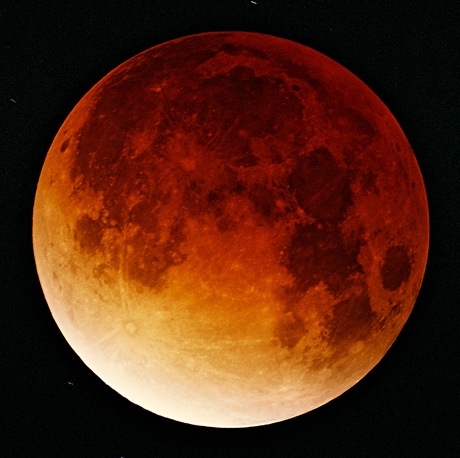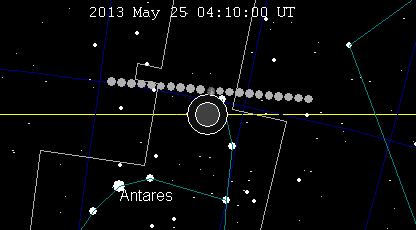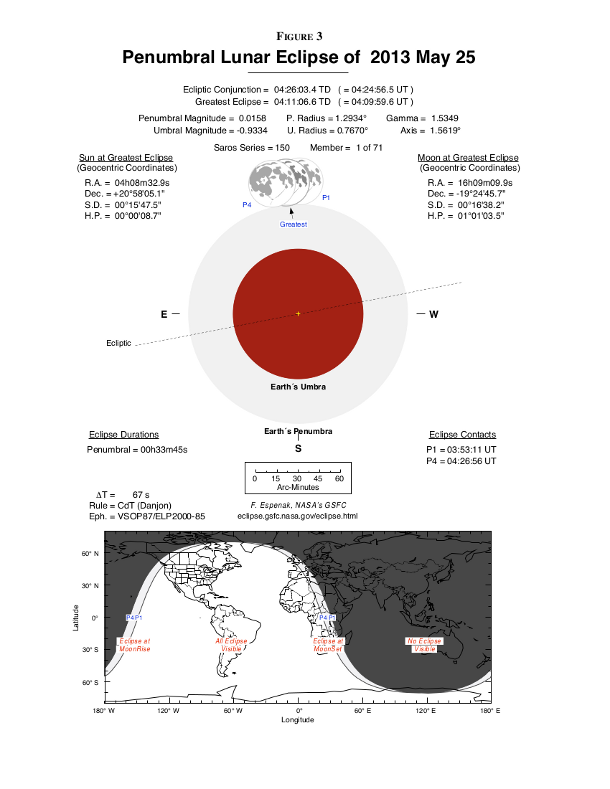Penumbral lunar eclipse on May 25, 2013

The second lunar eclipse of 2013 occurs at the Moon's ascending node in Scorpius about 7° northwest of Antares (mv = +1.07). With a penumbral eclipse magnitude of 0.0158, just 0.5 arc-minutes of the Moon's southern limb will pass into Earth's pale penumbral shadow; such a shallow eclipse is only of academic interest since it will be very difficult to detect.

May 25, 2013 lunar eclipse chart.The position of the moon (and earth's shadow) are shown as viewed from center of earth (small parallel occurs from specific location on surface of the earth). The moon is drawn at maximum eclipse, and circles for every hour of motion. (Credit: Wikimedia)
Penumbral Eclipse begins at 03:53:11 UTC on May 25, 2013 and ends at 04:26:56 UTC. Greatest eclipse will be visible at 04:10:00 UTC.

The image above shows the path of the Moon through the penumbra as well as a map showing the geographic regions of visibility. (Credit: NASA/GSFC)
During the event, the Moon will be visible from the Americas and western Africa. The penumbral lunar eclipse on May 25, 2013 is the very first eclipse of Saros 150 cycle. The next occurrence will also be a penumbral eclipse on June 5, 2031. Partial eclipses in Saros 150 series will occur between August 20, 2157 and past the year 3000. Total eclipses will occur between April 29, 2572 and August 28, 2770.
Types of lunar eclipse

Schematic diagram of the shadow cast by the Earth. Within the central umbra shadow, the Moon is totally shielded from direct illumination by the Sun. In contrast, within the penumbra shadow, only a portion of sunlight is blocked. (Credit: NASA/Wikimedia/Sagredo)
The shadow of the Earth can be divided into two distinctive parts: the umbra and penumbra. Within the umbra, there is no direct solar radiation. However, as a result of the Sun’s large angular size, solar illumination is only partially blocked in the outer portion of the Earth’s shadow, which is given the name penumbra. A penumbral eclipse occurs when the Moon passes through the Earth’s penumbra. The penumbra causes a subtle darkening of the Moon's surface. A special type of penumbral eclipse is a total penumbral eclipse, during which the Moon lies exclusively within the Earth’s penumbra. Total penumbral eclipses are rare, and when these occur, that portion of the Moon which is closest to the umbra can appear somewhat darker than the rest of the Moon.
.png)
A total penumbral lunar eclipse dims the moon in direct proportion to the area of the sun’s disk blocked by the earth. This comparison shows the southern shadow penumbral lunar eclipse of January 1999 (left) to the same moon outside of the shadow (right) demonstrates this subtle dimming. (Credit: Wikimedia)
A partial lunar eclipse occurs when only a portion of the Moon enters the umbra. When the Moon travels completely into the Earth’s umbra, one observes a total lunar eclipse. The Moon’s speed through the shadow is about one kilometer per second (2,300 mph), and totality may last up to nearly 107 minutes. Nevertheless, the total time between the Moon’s first and last contact with the shadow is much longer, and could last up to 4 hours. The relative distance of the Moon from the Earth at the time of an eclipse can affect the eclipse’s duration. In particular, when the Moon is near its apogee, the farthest point from the Earth in its orbit, its orbital speed is the slowest. The diameter of the umbra does not decrease appreciably within the changes in the orbital distance of the moon. Thus, a totally eclipsed Moon occurring near apogee will lengthen the duration of totality.
The timing of total lunar eclipses are determined by its contacts:
P1 (First contact): Beginning of the penumbral eclipse. The Earth's penumbra touches the Moon's outer limb.
U1 (Second contact): Beginning of the partial eclipse. The Earth's umbra touches the Moon's outer limb.
U2 (Third contact): Beginning of the total eclipse. The Moon's surface is entirely within the Earth's umbra.
Greatest eclipse: The peak stage of the total eclipse. The Moon is at its closest to the center of the Earth's umbra.
U3 (Fourth contact): End of the total eclipse. The Moon's outer limb exits the Earth's umbra.
U4 (Fifth contact): End of the partial eclipse. The Earth's umbra leaves the Moon's surface.
P2 (Sixth contact): End of the penumbral eclipse. The Earth's shadow no longer makes any contact with the Moon.
Sources: Eclipse.GSFC/NASA, Wikipedia

Actually the full moon is on 24th may 2013 in India Kerala Kozhikode +5 1/2 hr, then, why the Penumbral Eclipse Happends on 25th may also? It is a fact that the Full moon is a global phenomenon where Sun set and Moon rise at 180 degree in ecliptic plane and it is on 24th may Friday?